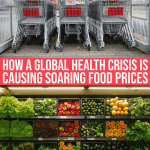Going to the grocery store is one of those unavoidable chores that might have been once a month, once a week, or even a daily occurrence in your household. At the start of the pandemic, this activity might have felt more like an annoying chore because of how difficult it became. Being conscious of food prices might have slipped your mind as you were just trying to ensure you could eat and feed your family. Fast forward and we are still in a pandemic and while there is less panic around being able to get food there is more discomfort around rising food prices.
We have all seen the memes poking fun at how much people are spending on groceries during this global health crisis. The monthly budget for gas = $0, dinner out = $0, shopping = $0, groceries $1,857 and we can all relate. The thought might be that eating in for three meals a day plus snacks adds up, right? Well maybe, but not exactly. In addition to purchasing more food or maybe not sticking to only getting items on your list, food prices have increased, and here are some reasons why.
Read More: 10 Best Apps For Meal Planning

Why Have Food Prices Drastically Increased?
Did you know that the average person spends about 53 hours per year at the grocery store? Break that down to making approximately 1.5 trips per week at 41 minutes per trip. That being said, people are pretty familiar with what they are spending each time they go and are also noticing the number at the end of their receipt is getting higher and higher. It may seem odd as the news continues to discuss slashing prices at the gas pump, airline and travel prices having drastically decreased and apparel seeming to be constantly on sale. So why the increase in food prices?
In April, the price of groceries increased by 26% and that number includes the typical seasonal adjustments. According to the Bureau of Labor Statistics, that is the largest increase month to month seen since 1974. The reasoning behind this could be a couple of different factors. First, let’s look at demand. At the beginning of this crisis, it may have been harder to get the items you wanted so there might have been multiple trips and to multiple stores. So as people continue to go to the store they are stocking up on more items to ensure they have enough food should another shutdown happen and it also limits the number of times they are making trips to the grocery store.

Second, as restaurants and schools closed for the temporary shutdown, shifting to eating at home shook up the food industry a ton. There are seasonal dining patterns that American’s follow and according to Action Economics, there is a national food supply chain that has been drastically disrupted by all of this. Distributors are looking at their supply chain and actually having to physically package items differently. Take, for example, milk for school. It might have been supplied in half-pint cartons for individual schools and now needing to be packaged in half or full gallons for grocery stores. That is definitely going to decrease supply and increase those prices.
Lastly, let’s look at food production. Even before the pandemic, there was talk about global food prices increasing for many reasons, one big factor being global warming. Also, remember the African swine flu last year that knocked out over one-quarter of the world’s pig population and more recently the locus blight that destroyed all crops in East Africa. Add in exporting bans and you have the perfect storm. But wait, it is not over. Who is going to harvest crops, manage slaughterhouses, and transport goods if people are becoming infected by the virus on a daily basis? All of these things have a trickle-down effect that ultimately affects our food prices.

Read More: The 5 Best Grocery Delivery Services: A Comprehensive List
Food Banks Feeling The Food Prices
Food insecurity is a growing problem in the United States. Nearly 30 million Americans reported they did not have enough to eat which is the highest number seen since the Census tracking started in May. As the Coronavirus continues to affect the job market, and the food supply chain, food banks are also at the top of the list being hit hard with extra pressure. Prior to the pandemic, local food pantries would receive surplus supplies from supermarkets and food companies. As customers are buying more food in bulk it is leaving shelves barer which means fewer donations to food banks.
As food banks are being struck with fewer donations and fewer volunteers, the demand for food assistance is rising at an enormous rate. Food banks are reporting hundreds of more people every day waiting in line for services and the number does not appear to be slowing down. Adding another layer to this crisis is that as schools continue to stay closed or distance learning is required in some areas, those families who relied on free or subsidized food for their children are facing an even greater need to keep their families fed.

Read More: Charitable Donations During A Pandemic: Here’s How To Make A Difference
How To Stretch A Weekly Food Budget
As food prices continue to rise and fluctuate, here are some manageable tips on how to make that grocery budget go a little further.
- Check Weekly Ads: Buy food on sale. If ground beef is not on sale but ground chicken is, swap them out in your recipe. Switching the more affordable option for that week can save cents, maybe even dollars, and might even add a new flavor to your dish.
- Buy In Bulk: If you can afford to do this, buying in bulk can actually lower the cost of particular items. Freezing what you don’t use right away is a good way to stretch the cost and the food item.
- Eat More Vegetables: Planning a couple of meals a week of all vegetables with added supplements such as pasta, rice, or beans is a great way to keep down costs. Also purchasing vegetables from your local farmers market can sometimes reduce prices significantly depending on what is in season.
- Low-Cost Staples: Adding whole grains is always great for our guts so stock up on rice, oats, quinoa, couscous, and legumes (beans). Despite rising food prices, these are still relatively inexpensive. Add these to bulk up any vegetable dish or salad. Buying frozen vegetables is also a way to keep a healthy diet while not paying for the freshness cost.

- Package and Freeze: As soon as you are home from the store and before putting everything away, package and freeze whatever you are not going to use. For example, if the casserole recipe is only going to take half of the ground turkey meat freeze the other half a pound for something delicious later on. It is easier to take it out of the freezer to use instead of letting it sit all week then decide you’re sick of looking at it. At that point, it may be too late.
- Eat Leftovers: Eating leftovers is not always a fan favorite. This is definitely a way to stretch out a meal, especially if there are 3-4 people but the recipe makes for 6-8. If you are not a leftover person and your meal can freeze easily, package, and freeze for a future date that way it won’t feel like your eating leftovers.
- Fridge Foraging: At the end of each week you may have a bunch of random things in your fridge. This is a great time to be creative and throw something together with those cold items from your refrigerator and your pantry staples. Make sure you have a cooking fat (oil or butter) and get ready for roasting, sauteeing, or even grilling depending on your items.
As the pandemic continues to spread across much of the United States, food prices continue to rise. As Americans continue to stay home and eat in, there are ways to stretch the grocery budget to spend less time and money on each trip you make. The future for the food industry is very uncertain during this time so it is important now to plan what you can for the future. Not everyone is fortunate enough to have a food budget so donating money and/or time if you have the extra to do so could go a long way. Stay safe and healthy people and always remember to wear your mask!
WANT TO READ MORE?
Check out this article on National School Breakfast Week: The Case For Feeding Our Kids.
💖 NEWSLETTER: DAILY READS IN YOUR INBOX 💖
Sign up to receive our picks for the best things to do, see and buy so you can relax and focus on more important tasks! Let us help you be the best version of yourself you can be!
GET MORE FROM DAILY MOM, PARENTS PORTAL
Newsletter: Daily Mom delivered to you
Facebook: @DailyMomOfficial
Instagram: @DailyMomOfficial | @DailyMomTravel | @BestProductsClub
YouTube: @DailyMomVideos
Pinterest: @DailyMomOfficial
📌 LOVE IT? PIN IT!📌










































